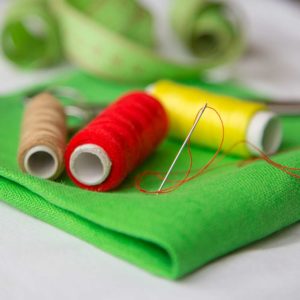 No matter how warm the yarn is, the knitted hat is still blown by the wind. Even Italian merino or alpaca will not protect your ears in cold winter. Therefore, the lining is simply necessary. Of course, you can knit it from fluffy wool or soft fancy yarn, but this takes time. Much easier and faster to sew. But this is not the only advantage. A knitted hat with fleece inside will not allow you to freeze at minus 25–30 °C; it is suitable even for the Siberian winter.
No matter how warm the yarn is, the knitted hat is still blown by the wind. Even Italian merino or alpaca will not protect your ears in cold winter. Therefore, the lining is simply necessary. Of course, you can knit it from fluffy wool or soft fancy yarn, but this takes time. Much easier and faster to sew. But this is not the only advantage. A knitted hat with fleece inside will not allow you to freeze at minus 25–30 °C; it is suitable even for the Siberian winter.
What you need for the lining
Textile
Fleece can be thin or thick, single-sided or double-sided, and there are also special lining types. In any case, this material has undeniable advantages over other fabrics. He retains heat perfectly, does not require an overlocker or a sewing machine, stretches and fits perfectly on the head.
For the hat, you can choose any option at your discretion. It is desirable that the material matches the color. Then it can be seamlessly sewn to the knitted fabric. And the thread will not stand out outside or inside.For one lining, a piece 60–70 cm wide (depending on the head circumference plus overlap) and 30 cm high is enough.
Other materials and tools
 What else is needed for production:
What else is needed for production:
- threads to match the hat;
- threads to match the lining;
- tape measure;
- pencil or bar of soap;
- needle;
- scissors.
To create a pattern you will additionally need paper, a small piece is enough. You can also take a newspaper, but it gets wrinkled and won’t be very convenient. It's better to take A4 sheet.
Advice! If you plan to cut out fleece linings on an ongoing basis, it is recommended to immediately make a pattern template on cardboard.
You can sign what head circumference this template is for. This will save time in the future.
How to make a lining pattern
Although the pattern is extremely simple, it is not recommended to immediately draw on the fabric. The lining of a knitted hat usually consists of four or six identical wedges. There are also options in five parts. The more wedges, the better the hat will fit on your head.

Constructing a pattern
- Measure your head volume or just remember what size the hat was knitted for. Let's say 54 cm.
- Divide the head volume into 6 parts. It turns out 54/6=9 cm. Plus 1 cm added for seams.
- Measure the height of the hat. Let's say 20 cm. Add 1cm height for seam.
- Measure a 10 cm segment on paper. Find its middle and draw a perpendicular straight line up, mark a point after 21 cm.
- Draw two straight lines from the beginning and end of the segment upwards, mark points every 15 cm. Draw smooth lines from them to the central point.
- The result should be a piece resembling a smooth triangle. Cut out.
- For a cap of four wedges, the following calculations: 54/4 = 13.5 cm. Plus 1 cm for margin. This is the base of the triangle.Next, the pattern is constructed in a similar way.
Advice! Quite often, knitters use a regular iron as a template for a pattern. It just gives the desired triangle with smooth lines. But as you sew, you will have to adjust the size of the lining to the hat.
Making and sewing a fleece lining
Uncover
Attach the pattern to the fleece. Draw a pattern with a pencil, make four or six parts depending on the idea. It is not necessary to cut them out completely. Can be placed in the form of a “fence”. In this case, less time will be spent on seams. But you will also have to remove the stock of fabric from the pattern, which is placed on all sides at the seams.

How to sew a lining
Cut parts join with a rough seam. Check if everything matches. Insert the lining into the hat and once again make sure the measurements are accurate.
Sew all the parts together using thread to match the lining. You should end up with a dome-shaped fleece hat.
Sewing the lining

- Insert into a needle thread to match the knitted fabric.
- Position the lining inside a knitted hat, inside out. For fixation can be pinned to the top of the head or sew it on straight away.
- Sew on fleece piece to the hat with a seam “over the edge”. Preferably make small stitches, tighten the thread well. Then it will not be noticeable from the inside.
If the hat has ears, they can also be insulated.. To do this, simply trace on the fleece, but reduce the size. They sewn to the knitted fabric first. Then the edges are hidden under the main lining.
Fleece is a quick and convenient way to insulate something. Each time the process will take less and less time, and the result will delight you with neat and high-quality execution.


 0
0






Thanks for the clear and useful lesson. When I sew the darts on the top of the stretch fleece lining, it looks like hell. I came to the conclusion that this place is the “crossroads” of all darts; it is better to sew by hand. And then, wherever possible - on a sewing machine. And how do people manage to grind down all the wedges on the top of their heads beautifully? Straight up, hands down. I already have five hats lying around, waiting. But I don’t have the nerves to insulate them and finally finish the projects.